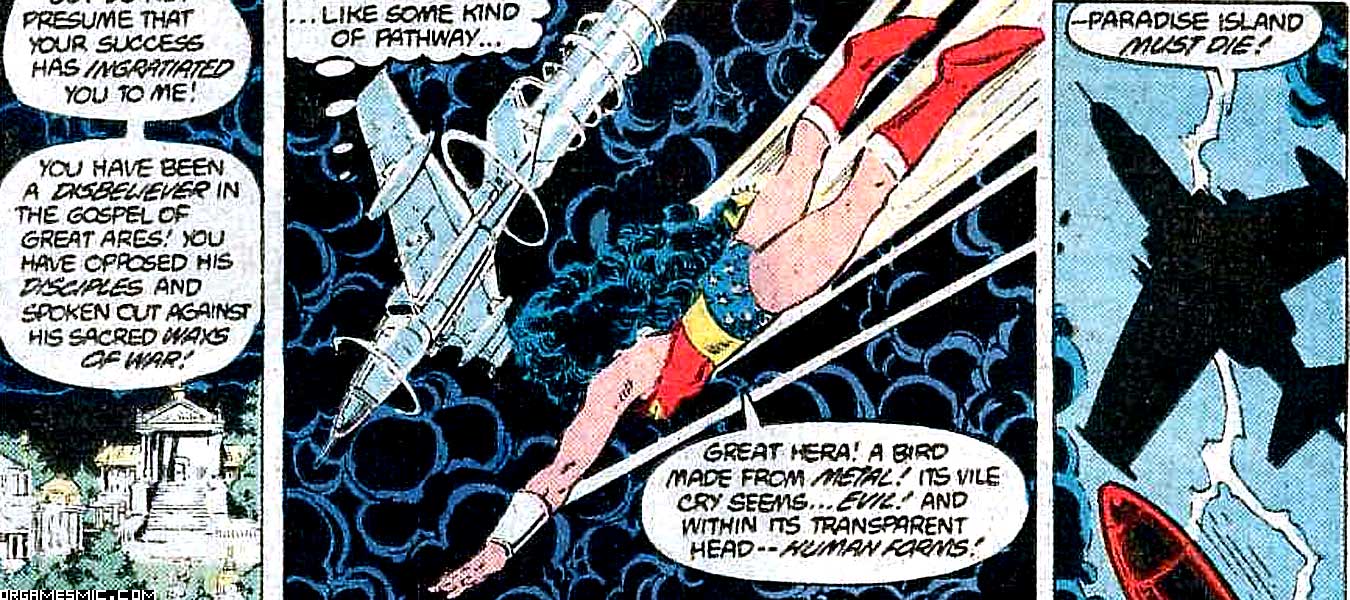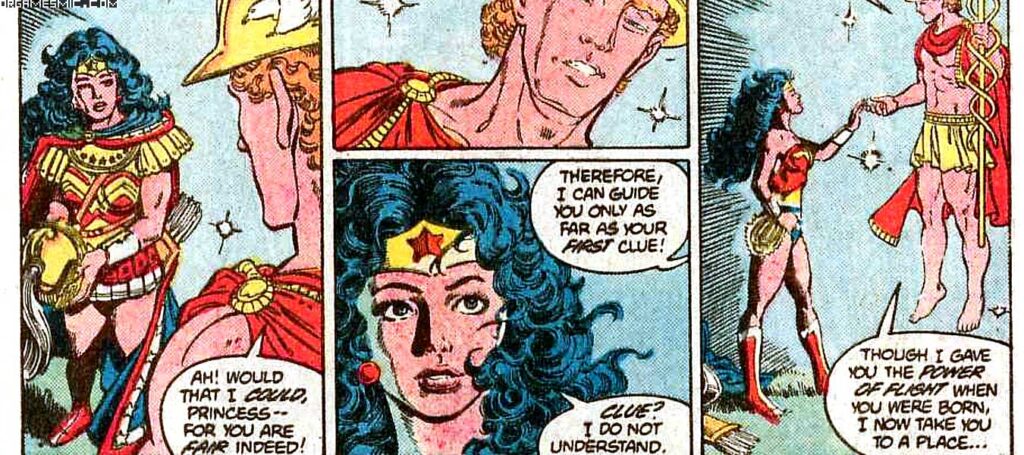This page may contain one or more affiliate links, which means that if you purchase a product through that link, I may receive compensation. The links will be identified with the text "affiliate link". Click to learn more.
This might seem like an odd question to some. The short answer is that before 1985, no and she had to use a invisible plane to get around. After 1986, her character, among other DC characters, went through a transformational change to help establish continuity and ground rules. At this point she was given the ability to fly and began to be arguably comparable to Superman and his abilities. But how do we know Wonder Woman can fly? In the 2017 movie, for example, it appears that she cannot fly at all. So we need to dig a little deeper for the explanation.
In 1985, the DC universe went through a transformation with the story arc Crisis on Infinite Earths. It was a terrible story and hard to follow, but it had to be done. With all of the different dimensions and stuff with different variations, things had to be simplified. And one of those simplifications was to give her the ability to fly rather than have to rely on an airplane. You see, before the transformation in the story arc Wonder Woman would get around in an invisible plane with peculiar properties. But since things had changed and she was given the gift of flight, the invisible plane was something that began to be neglected.
But how can Wonder Woman fly in the first place? The answer is in the first issue of Wonder Woman from 1987 (Affiliate Link). The Greek deities together created her out of clay and each one gave her a special attribute. Hermes, in particular, gave her the gift of flight. We can see her fly for the first time (since gaining her new abilities) in Wonder Woman issue 2. Hermes himself is present during the event.
In the movie Wonder Woman 1984, Steve Trevor (played by Chris Pine) is instrumental in helping Diana acquire her flying powers. Diana and Steve fly a fighter jet to follow Maxwell Lord (Pedro Pascal) as he heads towards Cairo, Egypt, where their paths finally meet. During their journey, Diana contemplates the lessons that Steve shared about flying: “It’s so easy, really. It’s wind and air and knowing how to ride it, how to catch it.” Abandoning the wish that she no longer had superpowers and out of her natural pace, Diana shot out with her Lasso of Truth. She used the lasso to catch a passing airliner, launching herself thousands of feet into the sky.
How Does Wonder Woman Fly?
Let us explore the phenomenon of Diana flying based on how kites navigate through space. Kite flying has been around for centuries, and people have always been fascinated by how a simple kite can soar so high up in the sky. One of the main factors that determine the flight of a kite is its aerodynamics.
There is a delicate and exquisite interaction between lift, drag, weight, and thrust, allowing kites to ascend into the sky. The forces are integrated with each other and will ensure that the kite stays in the air. The basic principles hold true whether it is an Airbus of colossal proportions or a lightweight kite.
The kite flies because there is an unequal air pressure on its upper and lower sides that results in lift. When the wind blows at the sail, it does not go straight but it goes around. In the meantime, there is more air moving downwards than upwards as long as the angle between the kite and the wind is correct. It works as a lift that can overcome gravity and cause the ascent of the kite.
In contrast, drag is produced when the air rubs against the kite in its flow. The turbulent wind blows around a kite and reduces lift while enhancing drag. However, the force of the kite line prevents it from moving backwards due to drag.
The act of flying a kite can be divided into different stages, as seen with rockets and airplanes. Wind speed also plays an important role in this process. On days with windy conditions, it is as simple as giving the line a pull and up goes the kite; on calm days, you might have to take a few steps backward so that the wind can do its job to get the kite airborne.
A bridle is equipment designed for the rider to exercise some control over the horse.
By attaching the bridle to the kite, it helps determine the best flight angles into the wind. If you change where the flying line connects on the tow point, then this will influence how the kite will be affected by different wind directions. When moved closer to its nose, low wind speeds are ideal and with its tail, higher speeds.
The wind window is important when flying kites that can be steered, such as dual-line or quad-line kites. While moving across the window, the angle at which your kite meets the wind will change, affecting your power and control. The movements of your kite within this ever-changing realm are directed by visual and physical cues.
Bear in mind that proper control of a kite’s flight is achieved through maintaining an equilibrium between the above-mentioned forces—an elegant coordination with nature similar to that displayed by Wonder Woman in her manipulation of air streams. On your next kite-flying session, pay attention to its aerodynamic grace, which is also based on the same fundamental laws that enable Diana Prince to soar through the sky.


